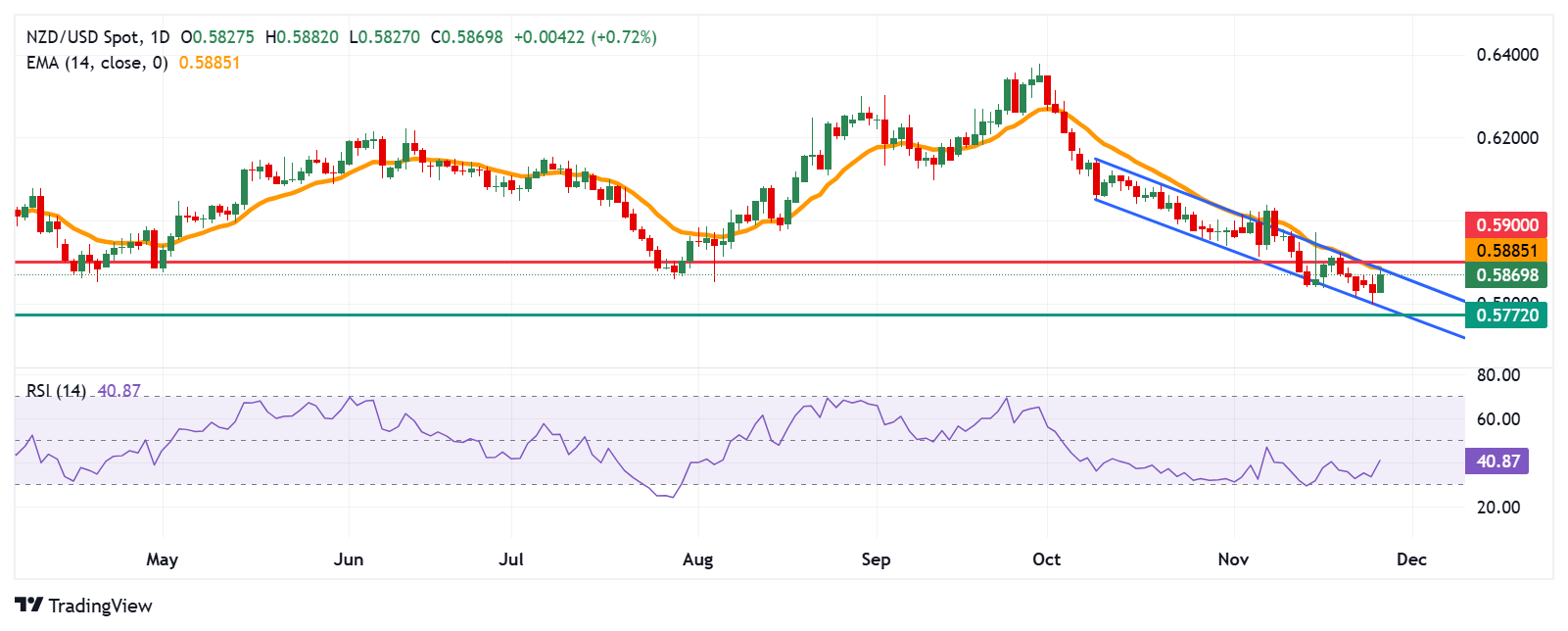- The New Zealand Dollar advanced when the RBNZ cut its Official Cash Rate by 50 basis points in November.
- The risk-sensitive NZD faced challenges when Donald Trump announced a plan to increase import tariffs on Chinese goods.
- The USD struggles due to bond market optimism following President-elect Donald Trump’s decision to nominate fund manager Scott Bessent.
The New Zealand Dollar (NZD) breaks its five-day losing streak against the US Dollar (USD) following the Reserve Bank of New Zealand’s (RBNZ) interest rate decision on Wednesday. The central bank announced a further cut to its Official Cash Rate (OCR), reducing it by 50 basis points (bps) from 4.75% to 4.25% in November.
The RBNZ justified this rate cut by citing a bleak economic outlook and a decline in inflation, which has now returned to the central bank’s target range of 1% to 3%. Earlier this year, the central bank reduced the OCR by 25 bps in August and followed up with a 50 bps reduction in October.
The NZD faced challenges due to weaker market sentiment, largely driven by President-elect Donald Trump’s announcement of a 10% increase in tariffs on all Chinese goods entering the United States (US). , as well as a 25% tariff on imports from Mexico and Canada. As China is a significant trading partner for New Zealand, any economic disruption in China has a direct impact on New Zealand’s economy.
New Zealand Dollar Appreciates as US Dollar Faces Challenges Due to Bond Market Optimism
- The USD faced pressure amid bond market optimism following President-elect Donald Trump’s decision to nominate fund manager Scott Bessent, a Wall Street veteran and fiscal conservative, as US Treasury Secretary.
- However, downside risks to the USD remain limited. Preliminary US S&P Global Purchasing Managers’ Index (PMI) data has reinforced expectations that the Federal Reserve could slow the pace of rate cuts. According to the CME FedWatch tool, the probability of a quarter-point rate cut has fallen to 57.7%.
- The latest meeting minutes of the Federal Open Market Committee (FOMC) for the monetary policy meeting held on November 7 indicated that policymakers are taking a cautious stance on reducing interest rates, citing the decline of inflation and a robust labor market.
- US President-elect Donald Trump is expected to name Jamieson Greer as US Trade Representative, Bloomberg reported on Tuesday. Greer’s nomination highlights the central role of tariffs in Trump’s economic strategy.
- On Tuesday, Chicago Fed President Austan Goolsbee indicated that the Fed is likely to continue lowering interest rates toward a neutral stance that neither stimulates nor restricts economic activity. Meanwhile, Minneapolis Fed President Neel Kashkari stressed that it remains appropriate to consider another rate cut at the Fed’s December meeting, according to Bloomberg.
- In November, the US S&P Global Composite PMI rose to 55.3, indicating the strongest growth in private sector activity since April 2022. Meanwhile, the US services PMI rose to 57.0, from 55.0, significantly exceeding market expectations of 55.2, marking the sharpest expansion in the services sector since March 2022.
- New Zealand’s Gross Domestic Product (GDP) contracted 0.2% in the second quarter (Q2), following a revised 0.1% growth in the previous quarter. Economists had anticipated a 0.4% contraction for the period, while the RBNZ forecast a 0.5% decline.
- NZ Stats showed on October 16 that New Zealand’s annual Consumer Price Index (CPI) rose 2.2% in the third quarter (Q3), aligning with market forecasts and marking a sharp slowdown from 3.3% growth. in the second quarter (Q2).
New Zealand Dollar tests upper boundary of descending channel near 0.5900
The NZD/USD pair is trading near 0.5880 on Wednesday. A review of the daily chart highlights a deepening bearish trend as the pair moves within a descending channel pattern. Meanwhile, the 14-day Relative Strength Index (RSI) remains below 50, signaling persistent negative sentiment.
As for its support, the NZD/USD pair could navigate the region around the psychological level of 0.5800, which coincides with the lower boundary of the descending channel. A decisive break below this level would take the pair towards its two-year low of 0.5772, last seen in November 2023.
To the upside, immediate resistance lies at the 14-day EMA of 0.5886, which aligns with the upper boundary of the descending channel. An additional barrier appears at the psychological level of 0.5900.
NZD/USD: Daily Chart
New Zealand Dollar PRICE Today
The table below shows the percentage change of the New Zealand Dollar (NZD) against major currencies today. New Zealand dollar was the strongest currency against the US dollar.
| USD | EUR | GBP | JPY | CAD | AUD | NZD | CHF | |
|---|---|---|---|---|---|---|---|---|
| USD | -0.07% | -0.13% | -0.29% | -0.09% | -0.24% | -0.73% | -0.12% | |
| EUR | 0.07% | -0.06% | -0.21% | -0.02% | -0.17% | -0.67% | -0.04% | |
| GBP | 0.13% | 0.06% | -0.15% | 0.04% | -0.11% | -0.61% | 0.00% | |
| JPY | 0.29% | 0.21% | 0.15% | 0.19% | 0.05% | -0.44% | 0.16% | |
| CAD | 0.09% | 0.02% | -0.04% | -0.19% | -0.16% | -0.65% | -0.04% | |
| AUD | 0.24% | 0.17% | 0.11% | -0.05% | 0.16% | -0.50% | 0.11% | |
| NZD | 0.73% | 0.67% | 0.61% | 0.44% | 0.65% | 0.50% | 0.61% | |
| CHF | 0.12% | 0.04% | -0.00% | -0.16% | 0.04% | -0.11% | -0.61% |
The heat map shows percentage changes for major currencies. The base currency is selected from the left column, while the quote currency is selected from the top row. For example, if you choose the New Zealand Dollar from the left column and move along the horizontal line to the US Dollar, the percentage change shown in the box will represent the NZD (base)/USD (quote).
economic indicator
Interest rate decision
RBNZ Interest Rate Decision Announced by the Reserve Bank of New Zealand.This rate affects a range of interest rates set by commercial banks, building societies and other institutions towards their own savers and borrowers. It also tends to affect the price of financial assets, such as bonds, stocks and exchange rates, which affect consumer and business demand in a variety of ways.
Last post:
Wed Nov 27, 2024 01:00
Frequency:
Irregular
Current:
4.25%
Dear:
4.25%
Previous:
4.75%
Fountain:
Reserve Bank of New Zealand
The Reserve Bank of New Zealand (RBNZ) holds monetary policy meetings seven times a year, announcing its decision on interest rates and the economic assessments that influenced its decision. The central bank offers clues about the economic outlook and future policy path, which are highly relevant to the valuation of the NZD. Positive economic developments and optimistic outlook could lead the RBNZ to tighten policy by raising interest rates, which tend to be bullish for the NZD. Policy announcements are usually followed by Governor Adrian Orr’s press conference.
Source: Fx Street
I am Joshua Winder, a senior-level journalist and editor at World Stock Market. I specialize in covering news related to the stock market and economic trends. With more than 8 years of experience in this field, I have become an expert in financial reporting.








